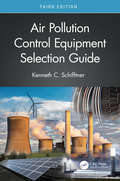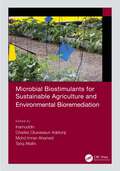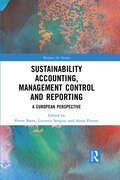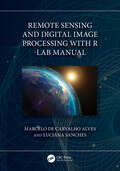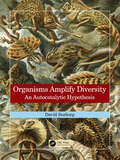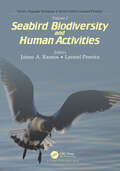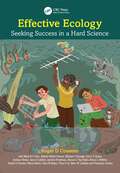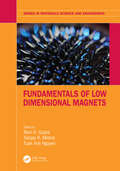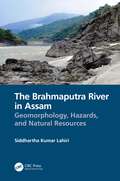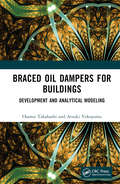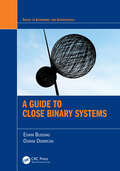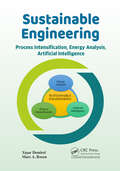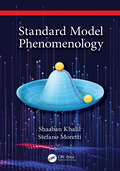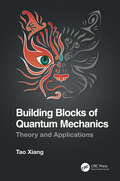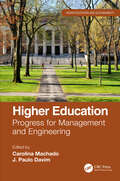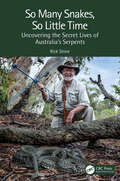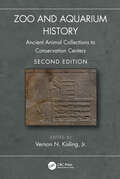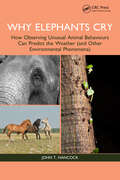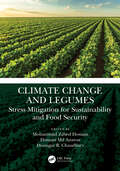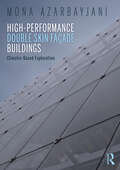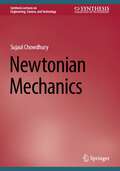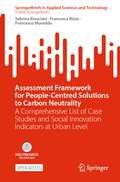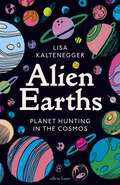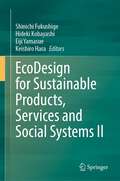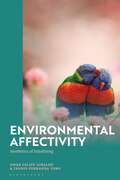- Table View
- List View
Air Pollution Control Equipment Selection Guide
by Kenneth C. SchifftnerThis new edition of Air Pollution Control Equipment Selection Guide builds upon the successes of previous editions that developed a detailed discussion on various technologies used for air pollution control. This book covers a wide range of equipment and provides a good overview of the related principles and applications. A particularly valuable feature are the practical examples, not commonly available in other books. Based on the author’s fifty years of experience in applying and operating air pollution control equipment, this book provides easy-to-read information on basic air pollution control technology and is the quintessential resource for the busy engineer and for those who do not have formal training in air pollution control.FEATURES OF THE THIRD EDITION Uniform and consistent applications information for comparing the effectiveness of different technologies. Provides answers to questions about how to reduce operating costs and how to achieve peak performance. Concise descriptions of each equipment with diagnostics and testing suggestions. New chapters on optimization techniques that help readers deal with different types of hardware for better performance and efficacy.
Microbial Biostimulants for Sustainable Agriculture and Environmental Bioremediation
by InamuddinToday, the agriculture industry is confronted with simultaneous issues of how to fully embrace mass production of safer food in terms of both quality and quantity. Most industries are concerned with avoiding significant levels of soil pollution and environmental threats as a result of the excessive and harmful use of synthetic products on crops. Therefore, there is a need to adopt sustainable technological innovations that can ensure the sustainability of agricultural production systems.Microbial Biostimulants for Sustainable Agriculture and Environmental Bioremediation discusses the benefits, challenges, and practical applications of eco-friendly biotechnological techniques using biostimulants derived from beneficial microorganisms. The chapters cover the use of these organisms to increase crop production, enhance soil fertility and maintain soil health, create crop and plant tolerance to different abiotic stressors, release required nutrients to the soil, increase resistance to plant pathogens/pests, improve nutrient use efficiency of crops, and rejuvenate polluted environments.FEATURES Explores the physiological, morpho-anatomical, and biochemical molecular plant rejoinders involved in stimulating crop productivity Provides information on the physiological, cellular, and molecular modes of action underlying microbial biostimulant interfaces Summarizes methods and approaches for executing microbial stimulant technology Outlines numerous environmental management and remediation strategies This book is an ideal resource for researchers, engineers, and academics working in soil science, crop science, water remediation, microbiology, and biotechnology.
Sustainability Accounting, Management Control and Reporting: A European Perspective (Business for Society)
by Pierre BaretSustainability Accounting, Management Control and Reporting: A European Perspective traces a picture of innovative performance measurement tools and approaches to drive organizations to implement their shared value and sustainability strategy, considering different perspectives around accounting, managerial control and reporting. In recent years, organizations managing their responsible approach with relevance and pressure from stakeholders and regulations has proven to be a major challenge. During the first two decades of the 21st century, many companies have reached a real maturity in this area and have deployed coherent responsible approaches that are integrated into their overall strategy. It is now a matter of steering these responsible approaches from an accounting and managerial standpoint, but also of reporting on them. It requires the simultaneous use of comprehensive accounting, controlling and reporting tools. This book provides an innovative perspective on sustainable management control, comprehensive accounting and integrated reporting, presenting the most recent proposals and the main critical issues. Aimed at researchers, academics, managers, business leaders and advanced students, the book will be especially valuable to those in the fields of corporate social responsibility, strategic management, and accounting.
Remote Sensing and Digital Image Processing with R - Lab Manual
by Marcelo de Carvalho Alves Luciana SanchesThis Lab Manual is a companion to the textbook Remote Sensing and Digital Image Processing with R. It covers examples of natural resource data analysis applications including numerous, practical problem-solving exercises, and case studies that use the free and open-source platform R. The intuitive, structural workflow helps students better understand a scientific approach to each case study in the book and learn how to replicate, transplant, and expand the workflow for further exploration with new data, models, and areas of interest. Features Aims to expand theoretical approaches of remote sensing and digital image processing through multidisciplinary applications using R and R packages. Engages students in learning theory through hands-on real-life projects. All chapters are structured with solved exercises and homework and encourage readers to understand the potential and the limitations of the environments. Covers data analysis in the free and open-source R platform, which makes remote sensing accessible to anyone with a computer. Explores current trends and developments in remote sensing in homework assignments with data to further explore the use of free multispectral remote sensing data, including very high spatial resolution information. Undergraduate- and graduate-level students will benefit from the exercises in this Lab Manual, because they are applicable to a variety of subjects including environmental science, agriculture engineering, as well as natural and social sciences. Students will gain a deeper understanding and first-hand experience with remote sensing and digital processing, with a learn-by-doing methodology using applicable examples in natural resources.
Organisms Amplify Diversity: An Autocatalytic Hypothesis
by David SeaborgThis book presents a hypothesis and evidence that organisms promote and ecosystems maximize biodiversity. All species have a net positive effect on their environment, other species, and diversity. The sun is 30% hotter than when life began, but the temperature has been kept moderate by life. Life created high oxygen, the ozone layer, and fertile soil, a diverse, living system. No species evolves in isolation, and most evolution is coevolution. The nature and number of links between species are as important as species number. Eukaryotes coevolve with complex ecosystems of microbes with which they exchange genes. Genomes and intraspecific interactions both act to promote evolution and diversification. Viruses increase diversity of their hosts and cause macroevolutionary transitions. Key Features Life alters the Earth in ways that increase biodiversity All species make their environment better for other species and promote diversity Life created the life-friendly atmosphere, temperature, and soil of today
Volume 1: Seabird Biodiversity and Human Activities (Aquatic Sciences)
by Jaime A. RamosSeabirds are global travellers connecting oceans and seas all over the world, and facing multiple threats at local and global scales. Seabirds are long-lived top predators, reflecting changes at lower trophic levels, and are good models to assess ecological changes produced by human societies. Thus, world-wide collaborations are needed to understand seabird ecology and to develop effective conservation measures benefitting both humans and seabird populations.This book provides a modern overview on seabird biodiversity studies: it begins by covering the most up-to-date techniques to study seabirds, and then focus on pragmatic issues related with interactions between seabirds and humans, the use of seabirds as ecological indicators and conservation of seabirds. It gives an updated insight on all these topics and highlights gaps that need further development for a comprehensive understanding of the relationships between seabirds and human actions.This book covers the response of the seabird research community to a biodiversity crisis aiming to contribute towards environmental sustainability. It should provide inspiration to a wide range of professionals and students, including the much needed world-wide collaboration between research groups and practitioners. In this way seabird research and conservation provide an inspiration for the solution of global issues such as climate change.
Effective Ecology: Seeking Success in a Hard Science
by Roger D. CousensEcology is one of the most challenging of sciences, with unambiguous knowledge much harder to achieve than it might seem. But it is also one of the most important sciences for the future health of our planet. It is vital that our efforts are as effective as possible at achieving our desired outcomes. This book is intended to help individual ecologists to develop a better vision for their ecology – and the way they can best contribute to science. The central premise is that to advance ecology effectively as a discipline, ecologists need to be able to establish conclusive answers to key questions rather than merely proposing plausible explanations for mundane observations. Ecologists need clear and honest understanding of how we have come to do things the way we do them now, the limitations of our approaches, our goals for the future and how we may need to change our approaches if we are to maintain or enhance our relevance and credibility. Readers are taken through examples to show what a critical appraisal can reveal and how this approach can benefit ecology if it is applied more routinely.Ecological systems are notable for their complexity and their variability. Ecology is, as indicated by the title of this book, a truly difficult science. Ecologists have achieved a great deal, but they can do better. This book aims to encourage early-career researchers to be realistic about their expectations: to question everything, not to take everything for granted, and to make up their own minds.
Fundamentals of Low Dimensional Magnets (Series in Materials Science and Engineering)
by Ram K. Gupta Sanjay Mishra Tuan Anh NguyenA low-dimensional magnet is a key to the next generation of electronic devices. In some respects, low-dimensional magnets refer to nanomagnets (nanostructured magnets) or single-molecule magnets (molecular nanomagnets). They also include the group of magnetic nanoparticles, which have been widely used in biomedicine, technology, industries, and environmental remediation.Low-dimensional magnetic materials can be used effectively in the future in powerful computers (hard drives, magnetic random-access memory, ultra-low power consumption switches, etc.). The properties of these materials largely depend on the doping level, phase, defects, and morphology. This book covers various nanomagnets and magnetic materials. The basic concepts, various synthetic approaches, characterizations, and mathematical understanding of nanomaterials are provided. Some fundamental applications of 1D, 2D, and 3D materials are covered.This book provides the fundamentals of low-dimensional magnets along with synthesis, theories, structure-property relations, and applications of ferromagnetic nanomaterials. This book broadens our fundamental understanding of ferromagnetism and mechanisms for realization and advancement in devices with improved energy efficiency and high storage capacity.
The Brahmaputra River in Assam: Geomorphology, Hazards, and Natural Resources
by Siddhartha Kumar LahiriThis holistic book covers the richest area in North East India in terms of both explored and foreseen reserves of fossil fuels and other natural resources. Using a multidisciplinary approach, GIS, and geospatial data gathered from different case studies included, this book helps readers develop a thorough understanding of a highly dynamic big river, the Brahmaputra, and use it as a comprehensive resource for further understanding the science of rivers. It discusses the causal factors of decadal-scale fluvial dynamics, the nature of fluvial dynamics, lateral variability of the older flood plains and neotectonics in the shallow subsurface, and the overall trend of basin evolution at different depths.
Braced Oil Dampers for Buildings: Development and Analytical Modeling
by Osamu Takahashi Atsuki YokoyamaThe high damping force of oil damper vibration control systems in buildingsoffers relative safety during earthquakes and at a low environmentalcost. The oil damper is connected using braces in series and is installed withpins to the building structure, which minimizes the impact on the buildingstructure and allows installation and removal with ease.This is the first book detailing experimental work and cases of the use ofoil dampers in buildings. It shows their effectiveness by detailing the testingand analysis of buildings with them placed at braced positions, exposed tosmall amplitude vibration, and without them.• The only comprehensive presentation of oil damper vibration control• Covers analysis and design, with case studies and details of testingand experimental resultsThe book is organized systematically to suit students and junior professionalsin structural design as well as more specialist engineers. An additionalPython code sample is available online for learning the behaviors of oildampers (Jupyter Notebook environment required).Osamu Takahashi is a professor at Tokyo University of Science, founderof Science Kozo Inc., and an advisor to the New International StructuralDesign & Engineering Challenge Association, in Japan.Atsuki Yokoyama works in the Research and Development Departmentof Sanwa Tekki Corporation and has a PhD in Engineering from TokyoUniversity of Science.
A Guide to Close Binary Systems (ISSN)
by Edwin Budding Osman DemircanIntroduction to Close Binary Systems provides a comprehensive survey and guide to the fast-moving field of multiple, specifically binary, stars, with an up to date account of research around 'close', i.e. interacting pairs. Such interactions allow direct quantification of stellar properties, opening up factual insights into basic building blocks of the Universe.The book provides a much needed update for the seminal Close Binary Systems of Zdenĕk Kopal. Following a comparable plan, it presents relevant subject matter with an emphasis on building a framework of understanding to serve as a supporting resource for students and researchers. The text starts from a general historical background and progresses into the main theoretical ideas supporting our prima facie interpretation of observations. The central chapters explore further into these observational methods, arranged according to the classic subdivisions of astrometry, spectroscopy and photometry. Optimal inversion of observational data into model parametrization is a theme through these chapters. Significant here is the problem of how non-uniqueness in modelling affects interpretation. The underlying issues of stellar evolution bearing on observational evidence become paramount in the last four chapters. The book proceeds step-by-step from directly understandable examples of unevolved pairs to the challenging cases where stars are found in more and more extreme conditions, leading up to the mergers of massive black hole pairs seen in the new field of gravitational wave astronomy. This is a valuable reference for postgraduate and advanced undergraduate students working in mainstream areas of stellar astrophysics, with applications also to exoplanet research which shares some methodological features. Course designers for stellar astrophysics will find a useful selection of topics within this book.Key features:• Provides a well-explained and backgrounded, up-to-date account of close binary systems, in a fast-moving field of research that is growing in scientific importance• Surveys a wide range of case-studies within the context of binary and multiple star systems• Fills an acknowledged gap in current literatureCover Image: A public memorial to Zdenek Kopal in his home town (birthplace) of Litomysl in Czechia.
Sustainable Engineering: Process Intensification, Energy Analysis, and Artificial Intelligence
by Yasar Demirel Marc A. RosenSustainable engineering is of great importance for resilient and agile technology and society. This book balances economics, environment, and societal elements of sustainable engineering by integrating process intensification, energy analysis, and artificial intelligence to reduce production costs, improve the use of material and energy, product quality, safety, societal well-being, and water usage. The book provides comprehensive discussion of topics on process intensification, energy analysis, and artificial intelligence that include optimization, energy integration, green engineering, pinch analysis, exergy analysis, feasibility analysis, life cycle assessment, circular economy, bioeconomy, data processing, machine learning, expert systems, digital twins, and self-optimized plants for sustainable engineering.
Standard Model Phenomenology
by Shaaban Khalil Stefano MorettiThis new book is fully up to date with all the latest developments on both theoretical and experimental investigations of the Standard Model (SM) of particle physics with a particular emphasis on its historical development on both sides. It further stresses the cross-fertilisation between the two sub-disciplines of theoretical and experimental particle physics which has been instrumental in establishing the SM. In other words, the book develops a truly phenomenological attitude to the subject. In addition to emphasising the successes of the SM, this book also critically assesses its limitations and raises key unanswered questions for the purpose of presenting a new perspective of how to further our knowledge above and beyond it. It also contains both historical information from past experiments and latest results from the Large Hadron Collider at CERN.This book will be an invaluable reference to advanced undergraduate and postgraduate students, in addition to early-stage researchers in the field.Key Features: Provides a unique approach not found in current literature in developing and verifying the SM Presents the theory pedagogically but rigorously from basic knowledge of quantum field theory Brings together experimental and theoretical practice in one, cohesive text
Building Blocks of Quantum Mechanics: Theory and Applications
by Tao XiangThis textbook provides a concise yet comprehensive introduction to the principles, concepts, and methods of quantum mechanics. It covers the basic building blocks of quantum mechanics theory and applications, illuminated throughout by physical insights and examples of quantum mechanics, such as the one-dimensional eigen-problem, the harmonic oscillator, the Aharonov-Bohm effect, Landau levels, the hydrogen atom, the Landau-Zener transition and the Berry phase. This self-contained textbook is suitable for junior and senior undergraduate students, in addition to advanced students who have studied general physics (including classical mechanics, electromagnetics, and atomic physics), calculus, and linear algebra.Key features: Presents an accessible and concise treatment of quantum mechanics Contains a wealth of case studies and examples to illustrate concepts Based off the author's established course and lecture notes
Higher Education: Progress for Management and Engineering (Higher Education and Sustainability)
by Carolina MachadoIncreasing corporate social responsibility demands professionals possess the necessary knowledge, abilities, and competencies to answer the needs of a diverse organization’s stakeholders. This book highlights the most recent issues related to higher education in the fields of management and engineering. It explains why a sustainable education is a requirement for professionals, as well as the organizations they collaborate with.Higher Education: Progress for Management and Engineering focuses on the latest research findings in the field of higher and sustainable education. It discusses the progress, shares knowledge and insights on an international scale, and highlights the challenges faced to obtain and secure a more responsible and sustainable management system. Selecting different options and strategies, how to set priorities on managing competition, and how to succeed as an organization that can lead to successes in both national and international markets are covered within this book.This book can be used as a reference for researchers, academics, managers, engineers, and other professionals involved in higher and sustainable education in management and engineering.
So Many Snakes, So Little Time: Uncovering the Secret Lives of Australia’s Serpents
by Rick ShineSnakes are creatures of mystery, arousing fear in many people but fascination in a few. Recent research has transformed our understanding of the behaviour and ecology of these animals, revealed their important roles in diverse ecosystems, and discovered new and effective ways to conserve their populations and to promote coexistence between snakes and people. One of the leading contributors to that scientific revolution has been Prof Rick Shine. Based in Australia, whose snake fauna is diverse and often dangerous, his experiences and anecdotes will inspire a new generation of serpent scientists. Spellbinding stories highlight the challenges, frustrations, and joys of discovery, and give the reader a greater appreciation of these often-slandered slithering reptiles.Key Features Documents the important role played by a preeminent herpetologist. Focuses on research conducted in Australia, especially on snakes. Summarizes highly influential conservation studies. Explores the ways in which research has deepened our understanding of snakes.
Zoo and Aquarium History: Ancient Animal Collections to Conservation Centers
by Vernon N. Kisling Jr.Wild animals have been housed in zoos and aquariums for 5,000 years, fascinating people living in virtually every society. Today, these institutions are at a new milestone in their history. This second edition of Zoo and Aquarium History takes the reader on a journey through the transition of private collections to menageries, to zoos, then zoological gardens, and more recently conservation centers and sanctuaries. Under the direction of Vernon N. Kisling, an expert in zoo history, an international team of authors has thoroughly updated the only comprehensive, global history of animal collections, menageries, zoos, and aquariums. The resulting book documents the continuum of efforts in maintaining wild animal collections from ancient civilizations through today, explaining how modern zoos have developed their mission statements around the core aims of conservation, education, research and recreation. This new edition pulls together regional information, including new chapters on zoological gardens of Canada, Latin America, China, Israel, the Middle East, and New Zealand, along with the cultural aspects of each region to provide a foundation upon which further research can be based. It presents a chronological listing of the world's zoos and aquariums and features many never-before published photographs. Sidebars present supplementary information on pertinent personalities, events, and wildlife conservation issues. The original Appendix has been expanded to include over 1,200 zoos and aquariums, providing an invaluable resource. This is an extensive, chronological introduction to the subject, highlighting the published and archival resources for those who want to know more.
Why Elephants Cry: How Observing Unusual Animal Behaviours Can Predict the Weather (and Other Environmental Phenomena)
by John T. HancockWhy Elephants Cry is a fascinating frolic through the literature and evidence surrounding the use of unusual behavior of animals to measure and predict the environment. The role of animals, from the smallest ant to the biggest elephant, as predictors of environmental changes is framed around the climate crisis, which highlights the increasingly important part that animals will have to play in the future. Renowned biologist Professor John T. Hancock collects anecdotal stories and myths along with scientific evidence, demonstrating that observation of animals can be of tangible use. He looks at the measurement of the air temperature using ants, crickets and snakes, and goes on to assess the evidence that the observation of a wide range of animals can predict the weather or the imminent eruption of volcanoes and earthquakes. Evidence of animals being able to predict lunar and solar events, such as lunar cycles and the Northern Lights, is also considered. This is the only time that all this literature has been brought together in one place, a fascinating reference for anybody interested in animals and the environment. The book is also an ideal supplementary textbook for students studying animal behaviour.
Climate Change and Legumes: Stress Mitigation for Sustainability and Food Security
by Mohammad Zabed Hossain Hossain Anawar Doongar R. ChaudharyGlobal climate change has created unprecedented challenges for human civilization due to its widespread adverse consequences, including a reduction in crop yield and threatening food security across the globe. Among the crop plants, legumes have great potential for ameliorating global warming since they can reduce carbon emissions by lowering reliance on the application of chemical fertilizers, by increasing nitrification and carbon sequestration in soil, and by providing protein-rich diets to both humans and livestock. This book identifies the extent of climate-induced stresses on legume plants and focuses on achieving food security through sustainable agricultural practices.This book compiles recent research findings and reviews on climate-related problems, the potential of legumes in ameliorating the impacts of climate change, as well as better management of agricultural land and practices for achieving environmental sustainability and food security.This book will serve as guidelines for scientists, agricultural practitioners, and policymakers working to achieve food security and better management of climate-induced stresses in agricultural interventions. It will also be useful as a reference book for researchers and students of both graduate and postgraduate levels. Furthermore, this book will provide enhanced knowledge about the mechanisms of yield and stress tolerance of legumes as well as developing climate-smart crops and improving cropping systems for a sustainable environment and food security. Features of the book Reviews trends of global climate change and its consequences for food security across the continents Identifies the challenges and scopes of cultivating legumes in achieving food security in the context of global climate change Focuses on the improvements of legume production through conservation approaches in agricultural practices and modern techniques, including omics-based breeding, biotechnology, genetic engineering, and rhizobium technology Discusses the sustainable amelioration options for soils affected by climate-induced stresses Cites examples of applications of rhizobium technologies in reducing greenhouse gas emission Describes pathways associated with yield, resistance, and tolerance of legumes to climate-induced stresses
High-Performance Double Skin Façade Buildings: Climatic-Based Exploration
by Mona AzarbayjaniThis book provides a comprehensive theoretical platform for the use and construction of double skin façade projects. The DSF concept has been used mostly in European buildings; however, its success in other climates should be addressed. Increasing numbers of buildings are featuring double skin façade technology in the US; however, still relatively few have been studied for their performance in operation.This book gives architects a practical guide to analyze and evaluate the actual performance of double skin façade buildings in different climatic contexts. It is important for high-performance buildings to have tools to evaluate a design’s predicted performance to achieve specific sustainable goals. To determine that the application of DSF in different climates will provide better thermal comfort, building simulation tools analyze various thermal comfort parameters through studies of the façade and compare them with the actual building’s performance data. The book takes the reader on an on-site tour of eight DSF buildings around the US. Interviews with the buildings’ architects and engineers, owners, and users offer additional perspectives and insights into the construction and performance of these developments in building design.This will provide architects with a comprehensive understanding of the challenges and opportunities in integrating double skin façades into their projects.
Newtonian Mechanics (Synthesis Lectures on Engineering, Science, and Technology)
by Sujaul ChowdhuryThis book discusses topics related to Newtonian mechanics and is ideal for a one semester course. Introductory topics are first presented including: time, space, and matter; different coordinate systems; vectors; and unit vectors;. The author presents tools such as displacement, velocity, and acceleration to describe projectile motion and uniform circular motion. Newton’s laws of motion and concepts of force and mass are discussed followed by kinetic energy, potential energy, and both conservative and non-conservative forces. This class-tested book also introduces angular displacement, angular speed, and angular acceleration as well as the use of these to describe the motion of particles with constant angular acceleration. Concepts of torque, angular momentum, and rotational inertia are presented to explain the motion of physical pendulum. Motion under central force is also covered and Kepler’s laws are derived.
Assessment Framework for People-Centred Solutions to Carbon Neutrality: A Comprehensive List of Case Studies and Social Innovation Indicators at Urban Level (SpringerBriefs in Applied Sciences and Technology)
by Sabrina Bresciani Francesca Rizzo Francesco MuredduThis open access book presents a catalogue of over one thousand indicators which can be used by cities' public administrators to monitor and evaluate social innovation action plans to support people-centred, collaborative or co-designed solutions to lower carbon emissions. Indicators are clustered according to a framework of social innovation solutions for climate neutrality at city level, developed by merging top-down academic knowledge with bottom-up pragmatic case studies. There is currently limited guidance on how to embed social innovations in their cities’ action plans with the aim of reaching climate neutrality, and on how to assess the progress and impacts of such people-centred projects in cities. The book addresses this gap and is thus relevant for scholars in the field of policy-making and design, as well as cities’ transition teams, policymakers and consultants. Based on the work developed within the EU-funded project NetZeroCities, intervention logics are provided for each of the ten categories of action, with related indicators clustered by category and evaluation criteria (effectiveness, efficiency, relevance, replicability, and scalability). Guidelines to implement the framework support city administrators in defining steps they need to follow to apply the indicators to their local case, making social innovation a crucial lever for accelerating systemic transformation.
Alien Earths: Planet Hunting in the Cosmos
by Lisa Kaltenegger‘Lisa Kaltenegger offers first-hand access to her expertise on the search for planets in the universe, and the life they may contain. Along the way, Lisa's breezy narrative style invites you to experience with her the challenges and joys of being a scientist on the frontier of discovery’ Neil deGrasse Tyson, AstrophysicistFor thousands of years, humans have wondered whether we're alone in the cosmos. Now, for the first time, we have the technology to investigate. The question should have an obvious answer: yes or no. But once you try to find life elsewhere, you realize it is not so simple. How do you find it over cosmic distances? What actually is life?Astronomer Lisa Kaltenegger works from Carl Sagan’s former office at Cornell University, where she built a team of tenacious scientists from many disciplines to find life on faraway worlds, using Earth’s diverse biosphere and its history as a Rosetta Stone. With infectious enthusiasm, she provides an eye-opening insider’s guide to the most unusual exoplanets that have shaken our worldview – planets covered in oceans of lava, lonely wanderers lost in space, and others with more than one sun in their sky – as well as the best contenders for Alien Earths. She also shows how close imagined scifi worlds come to reality.We live in an incredible new epoch of exploration. As our witty and knowledgeable tour guide, Professor Kaltenegger shows how we discover not merely new continents, like the explorers of old, but whole new worlds circling other stars – and how we could spot life there. Worlds from where aliens may even be gazing back at us. What if we're not alone?
EcoDesign for Sustainable Products, Services and Social Systems II
by Shinichi Fukushige Hideki Kobayashi Eiji Yamasue Keishiro HaraThis 2-volume book highlights cutting-edge ecodesign research and covers broad areas ranging from individual product and service design to social system design. It includes business and policy design, circular production, life cycle design and management, digitalization for sustainable manufacturing, user behavior and health, ecodesign of social infrastructure, sustainability education, sustainability indicators, and energy system design. Featuring selected papers presented at EcoDesign 2021: 12th International Symposium on Environmentally Conscious Design and Inverse Manufacturing, it also includes diverse, interdisciplinary approaches to foster ecodesign research and activities. In the context of Sustainable Development Goals (SDGs), in particular SDG 12 (Responsible Consumption and Production), it addresses design innovations for sustainable value creation, considering technological developments, legislation, and consumer lifestyles. Further, the book discusses the conceptof circular economy, which aims to develop circular business models for resource efficient society by taking advantage of digital technologies including artificial intelligence, internet of things, digital twin, data analysis and simulation. Written by experts from academia and industry, Volume 2 focuses on the sustainability assessment of product lifecycle, waste management, material circularity and energy efficiency, food and agriculture, user behavior and health, and transportation. The methods, tools, and practices described are useful for readers to facilitate value creation for sustainability.
Environmental Affectivity: Aesthetics of Inhabiting
by Dr Omar Felipe Giraldo Ms Ingrid Fernanda ToroFollowing Spinoza's lead and Latin American environmental thought, this book imagines an embodied environmental ethics based on the relations between sentient beings and sustained by affections, sensibility, the senses, and contact. Engaging embodied, cognitive, phenomenological, aesthetic and psychoanalytic aspects of affectivity, Omar Felipe Giraldo and Ingrid Fernanda Toro help us understand how places inhabit us, and therefore, how places transformed lovingly have the immense capacity to modify the body, to redirect desire, to clarify our sensibility – creating an affectivity in direction opposition to the regime imposed by this global ecocidal capitalism.For the authors, the environmental crisis is more than a technological or economic problem. They see it as a threat to survival inscribed in the deepest foundations of our body, in the intimacy of our skin, in the intensity and tone of our affections, in our desires, in our perceptions and in our sensory-motor capacities. Hence, the immense need to dismantle this system of power embedded in the intimacy of our body and to cultivate a perceptual transformation guided by an empathic knowledge that leads to a different understanding of our belonging in that which exceeds us. This book is a vital manifesto on the political role of affects, an invitation to awaken the sensitive perception anesthetized by the ecologies of cruelty, and an urgent call to understand differently our place in the cosmos in the midst of this war that our civilization has declared on life.
